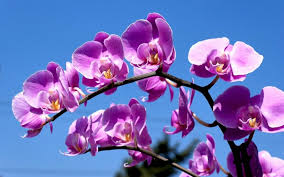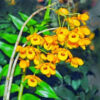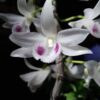# Guide to Creating a Small Dendrobium Orchid Garden at Home

Creating a small garden of Dendrobium orchids, particularly *Dendrobium nobile*, can be a rewarding experience. These beautiful orchids are known for their stunning flowers and relatively simple care requirements. This guide will provide you with detailed steps to design, set up, and maintain a small Dendrobium orchid garden at home, ensuring you enjoy the beauty of these remarkable plants.
## 1. Understanding Dendrobium Orchids
### 1.1 Overview of Dendrobium Orchids
Dendrobium orchids are a large genus of orchids that are prevalent in tropical and subtropical regions. They are characterized by their distinctive pseudobulbs and long-lasting blooms, making them popular among orchid enthusiasts. *Dendrobium nobile*, in particular, is celebrated for its vibrant flowers that can bloom in various colors, including white, yellow, pink, and purple.
### 1.2 Characteristics and Care Requirements
Dendrobium orchids require specific conditions to thrive. Understanding their needs is essential for creating a successful garden:
– **Light**: They prefer bright, indirect sunlight, ideally receiving around 1000 to 2000 foot-candles of light.
– **Temperature**: Dendrobium orchids thrive in temperatures between 65°F and 85°F (18°C to 29°C). They can tolerate short periods of cooler temperatures but should be protected from frost.
– **Humidity**: Maintaining humidity levels between 40% to 70% is crucial for their health.
– **Watering**: Watering should be done thoroughly when the top inch of the potting medium feels dry. Overwatering can lead to root rot.
– **Fertilization**: Regular fertilization during the growing season helps promote healthy growth and blooming.
## 2. Designing Your Small Dendrobium Orchid Garden
### 2.1 Selecting the Location
Choosing the right location for your Dendrobium orchid garden is critical. Consider the following factors:
– **Light Availability**: Look for a spot that receives bright, indirect sunlight for most of the day. East-facing windows are often ideal.
– **Temperature Control**: Ensure the area can maintain the appropriate temperature range. Avoid placing orchids near drafts, heating vents, or air conditioning units.
– **Accessibility**: Choose a location that is easy to access for watering, fertilizing, and general maintenance.
### 2.2 Choosing the Right Containers
Selecting the right containers for your Dendrobium orchids is essential for their growth:
– **Material**: Terra cotta pots are excellent for orchids as they are porous and allow for good airflow and drainage. Plastic pots retain moisture longer but may not provide adequate drainage.
– **Size**: Choose pots that are slightly larger than the root system of your orchids. This will provide enough space for growth without retaining too much moisture.
– **Drainage Holes**: Ensure that the pots have adequate drainage holes to prevent water accumulation.
### 2.3 Designing the Layout
Plan the layout of your orchid garden carefully. Consider the following:
– **Spacing**: Dendrobium orchids can grow large, so ensure they have enough space to spread without overcrowding. A distance of 6-12 inches (15-30 cm) between pots is usually ideal.
– **Height Variation**: If possible, create a tiered display using shelves or plant stands. This not only saves space but also showcases the orchids beautifully.
– **Mix of Plants**: While focusing on Dendrobium orchids, you can also incorporate other plants that thrive in similar conditions, such as ferns or bromeliads, to create a lush, tropical feel.
## 3. Potting and Planting Dendrobium Orchids
### 3.1 Preparing the Potting Mix
A suitable potting mix is essential for the health of your Dendrobium orchids. A good mix should provide adequate drainage, aeration, and moisture retention. Consider the following ingredients:
– **Bark Chips**: Use fir or pine bark chips as the primary component for aeration and drainage.
– **Sphagnum Moss**: Incorporate sphagnum moss for moisture retention.
– **Perlite**: Add perlite to enhance drainage.
– **Charcoal**: Horticultural charcoal can help absorb odors and impurities.
A common ratio for the potting mix could be:
– 40% Bark Chips
– 30% Sphagnum Moss
– 20% Perlite
– 10% Charcoal
### 3.2 Potting Your Dendrobium Orchids
1. **Remove the Orchid**: Gently take the orchid out of its nursery pot, being careful not to damage the roots.
2. **Inspect and Trim Roots**: Examine the roots and trim any dead or rotten sections using sterilized scissors.
3. **Fill the New Pot**: Place a layer of the prepared potting mix in the bottom of the new pot.
4. **Position the Orchid**: Place the orchid in the center, ensuring that the pseudobulbs are above the potting mix.
5. **Add More Mix**: Gradually fill in the potting mix around the roots, gently pressing to remove air pockets.
6. **Water Thoroughly**: After potting, water the orchid thoroughly to help settle the mix.
### 3.3 Repotting
Dendrobium orchids should be repotted every 1-2 years, or when the potting medium breaks down. Signs that repotting is needed include:
– **Decomposed Medium**: If the potting mix appears compacted or breaks down.
– **Root Bound**: If roots are visible through the drainage holes or are circling the pot.
## 4. Watering and Fertilizing Your Orchid Garden
### 4.1 Watering Techniques
Proper watering is crucial for the health of Dendrobium orchids. Here are some tips:
– **Watering Frequency**: Water when the top inch of the potting mix feels dry. Depending on the environment, this may be once a week or more frequently during hot weather.
– **Watering Method**: Water thoroughly until it drains from the bottom. Avoid letting the pot sit in standing water.
– **Humidity Management**: To increase humidity, place a humidity tray filled with water and pebbles under the pots or mist the orchids occasionally.
### 4.2 Fertilization
Regular fertilization supports healthy growth and blooming:
– **Fertilizer Type**: Use a balanced, water-soluble orchid fertilizer, ideally one formulated for Dendrobium orchids.
– **Dilution**: Dilute the fertilizer to half strength to prevent root burn.
– **Fertilizing Schedule**: Fertilize every 2-4 weeks during the growing season (spring and summer) and reduce during the dormant season (fall and winter).
## 5. Maintaining Your Dendrobium Orchid Garden
### 5.1 Pruning and Grooming
Regular grooming helps maintain the health and appearance of your Dendrobium orchids:
– **Pruning**: After blooming, prune back spent flower spikes to promote new growth. Cut just above the node to encourage branching.
– **Cleaning Leaves**: Wipe down leaves with a damp cloth to remove dust, allowing for better light absorption.
### 5.2 Monitoring for Pests and Diseases
Keeping an eye on your orchids for pests and diseases is essential:
– **Common Pests**: Watch for aphids, spider mites, mealybugs, and scale. Treat infestations promptly with insecticidal soap or neem oil.
– **Disease Prevention**: Root rot is a common issue caused by overwatering. Ensure good drainage and avoid letting the pot sit in water.
### 5.3 Providing Support
As Dendrobium orchids grow, they may require support to maintain their structure:
– **Stakes and Trellises**: Use stakes or trellises to support taller varieties and encourage upright growth.
– **Bamboo Stakes**: These are ideal for providing temporary support for young plants or flower spikes.
## 6. Creating a Beautiful Display
### 6.1 Designing Your Garden Aesthetically
Creating an aesthetically pleasing display enhances the enjoyment of your Dendrobium orchid garden:
– **Color Coordination**: Arrange orchids with complementary colors to create a harmonious display.
– **Layering**: Use plants of varying heights to create visual interest and depth.
– **Decorative Elements**: Incorporate decorative pots, stones, or other garden elements to enhance the overall design.
### 6.2 Incorporating Other Plants
Consider adding complementary plants to your Dendrobium garden:
– **Ferns**: Ferns thrive in similar humidity levels and can add lush greenery to your display.
– **Bromeliads**: These tropical plants can provide additional color and texture.
– **Succulents**: While not typically grouped with orchids, some succulents can thrive in similar conditions and add variety.
## 7. Seasonal Care for Dendrobium Orchids
### 7.1 Spring and Summer Care
During the growing season, focus on encouraging growth and blooms:
– **Increased Watering**: As temperatures rise, monitor moisture levels and increase watering frequency.
– **Fertilization**: Maintain a regular fertilization schedule to support blooming.
### 7.2 Fall and Winter Care
During the dormant season, adjustments are necessary:
– **Reduced Watering**: Decrease watering as growth slows down. Allow the potting medium to dry out more between waterings.
– **Temperature Management**: Ensure the orchids are kept in a warm area, protecting them from cold drafts.
## 8. Troubleshooting Common Issues
### 8.1 Poor Blooming
If your Dendrobium orchids are not blooming, consider the following:
–
**Light Levels**: Ensure they are receiving enough bright, indirect light.
– **Temperature**: Verify that the temperature is within the optimal range.
– **Age of Plant**: Some orchids may take time to mature before blooming.
### 8.2 Yellowing Leaves
Yellowing leaves can indicate several issues:
– **Overwatering**: Check for signs of root rot and adjust your watering schedule.
– **Nutrient Deficiency**: Ensure you are fertilizing regularly during the growing season.
## 9. Conclusion
Creating a small Dendrobium orchid garden at home can be a fulfilling and visually stunning project. By understanding the specific needs of Dendrobium orchids and following the steps outlined in this guide, you can cultivate a beautiful and thriving garden that brings joy and a touch of nature into your living space. With proper care, your Dendrobium orchids will flourish, rewarding you with their exquisite blooms for years to come. Embrace the beauty of these orchids and enjoy the tranquility they bring to your home.

